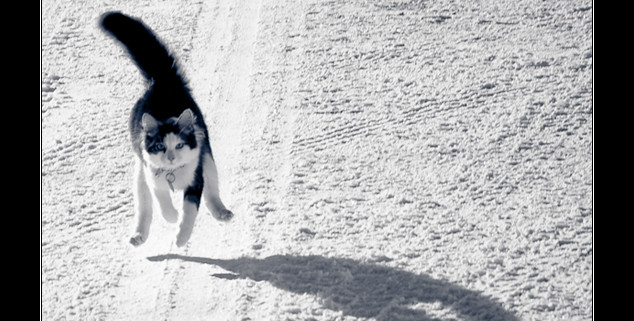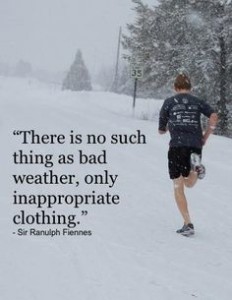Brrrr! Tips for Running Cold – Part 1 & 2!
Winter might mean colder weather, but that doesn’t mean you have to hang your running shoes up if you love the outdoors. With the right gear and the right information you can keep training for those up and coming 5ks , 10ks, and keep running on all 8 cylinders so to speak!
Part 1: Cold Weather Running Gear
First things first: What to wear and what not to wear.
What to wear: Think “Base Layer, Insulating Layer, and Outer Layer”. For your base layer and to stay comfortable in frigid weather, wear a microfiber shirt followed by a breathable windbreaker. If it’s really cold out, you’ll need an insulating layer, such as polar fleece, for added insulation. An outer layer, made of nylon or Gore-Tex will help protect you against wind and precipitation, while still letting out heat and moisture to prevent overheating and chilling. For pants, stick to running tights, and even something new known as “compression tights” if you can, rather than sweatpants or track pants which can weigh you down with cotton, as well as keeping moisture against your skin. If you don’t like running tights, or feel as though you look like a Christmas Elf running through town, aim for at least covering your knees and ankles to keep the joints warm and lubricated. Next, make sure you’ve got a good set of gloves or mittens that are thick and wind-resistant. Cold hands make you want to throw in the sweaty frozen towel and can even be painful. As much as 30% of your body heat escapes through your hands and feet. When it’s really cold, mittens are always a better choice than gloves, as mittens keep the fingers touching and your fingers will share their body heat. As for the feet, add a wicking sock liner under a warm polar fleece or wool sock in extreme cold, otherwise just a nice thin wool running sock like Merino brand will do. Make sure you have enough room in your running shoes to accommodate these thicker socks as your feet will tend to swell when you run. About 40% of your body heat is lost through your head, so keep your melon toasty with a beanie or even a face mask if it’s really cold out. Your circulatory system will have more heat and blood to distribute evenly throughout the body, keeping you from chilling. Ever suffer from “frozen mouth paralysis?” A face mask will filter cold air and make it warmer as it enters the lungs, which will not only leave with less risk for exercise induced asthma if you are prone to that, but also keep your lips warm and moist as you chat with your running buddy about the latest office gossip. And don’t forget those earmuffs or head wraps that will keep your ears as warm and toasty as a cuddle with John Stamos!
Best brands and fabrics to look for: Merino wool, Smartwool, Under Armor, run gear from Lululemon, PowerDry, CoolMax, Icebreaker, Salomon, Marmot, Athleta
What NOT to wear:
You’re going to warm up once you get moving, so it’s okay to start out the run a bit chilly when you start your run. Avoid big heavy clothing like hoodies and sweatpants that can be cumbersome and tend to be an pain to carry around as you run if you remove. Avoid cotton clothing as it keeps moisture on your body and can contribute to hypothermia*. Avoid cotton socks as again, which leave your feet wet and give them superhuman abilities of forming lovely water-logged blisters. Avoid cotton gloves or knit gloves as they will allow airflow in, somewhat defeating their entire purpose.
For shoes, choose running shoes that are not typically breathable like the ones you were trekking around in this summer. For winter you want a good solid, fitting shoe that has a good amount of traction for icy or wet roads. Avoid puddles and avoid running in rain or snow to lessen your risk of hypothermia*.
*A word of caution: If you get wet from snow, rain or sweat in cold temperatures, you’re more at risk for hypothermia. If you get wet, change your clothes and get inside to get warm as quick as possible. Hypothermia is characterized by intense shivering, loss of coordination, slurred speech, and fatigue.
Part 2 Cold Weather Running Tips
Hydration: A good rule of thumb is to hydrate before and after a run of 20-30 minutes, however if you plan to run any longer than that be sure to take some water with you. Even in cold weather while you may not feel like you are hot and sweaty you are losing more fluid than you realize as your body works hard to heat you. It’s essential to take in some fluid every 15 minutes past around 45 mins of running. And if you are like me and you kick back buckets of Kicking Horse Coffee (my favorite cup of jo) before your runs, be sure to drink equal amounts water to re-hydrate,…and be sure to know a good stopping point for a pee along your route too….ha. Side note on coffee: good quality organic pesticide-free coffee like Kicking Horse, won’t leave you with he pre-run jitters and actually doesn’t give you that “pee like a racehorse” feeling, since your body isn’t working hard to eliminate all the toxins that aren’t in it!! So as part of your pre-workout game plan, aim for a high quality (and tasty) coffee like Kicking Horse and you won’t be disappointed…or slow!
Stretching: Before a run, while you definitely want to warm up with a powerwalk or a light jog, you don’t necessarily have to stretch until after your workout. My advice: schedule a little extra time to warm up on a cold day with at least 8-12 minutes of power walking or light jogging before you set your pace for the rest of your run. Then once back at home or out of the cold, stretch those warmed up muscles by at least holding each stretch for 3-5 breaths and repeating each stretch 3x.
Fueling up before and after a run: Do you need a meal before or after your run? How much should you eat? Which foods are best? The answers: It depends. If you are going for a quick 20-30 minute jog, you won’t need much to jumpstart your energy for your run – just a cup of blueberries, or perhaps 1/2 a banana. I myself like a little fasted run and just have some swigs of BCAA’s which are Branch Chain Amino Acids that keep me from breaking down muscle, and leave me burning fat instead. Which is nice! Afterwards, having a bit of protein in the form of some eggs and a bit of carbs like berries or 1/2 cup of gluten-free oats would give your worked out muscles more helpful amino acids and good carbs to recover with. With a short run, a meal is not necessary. Some people are fine to even do short runs on an empty stomach and then refuel with a light meal afterwards. With longer runs, start with a little carb such as ½ cup of cottage cheese mixed with a cup of strawberries. It’s not always important has to how to fuel up before a run, but instead it’s much more crucial to fuel up after. Make sure in any case you always have a bit of protein and a bit of healthy carbohydrate within 30 minutes of your run to keep you running on all eight cylinders, or at least two strong, well-fed and warm legs!






Leave a Reply
Want to join the discussion?Feel free to contribute!